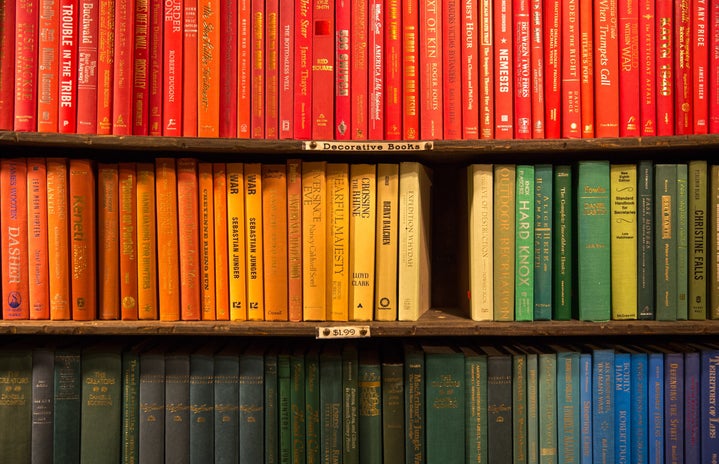Edited by: Shriya Adhikari
Over the years, there has been an increase in the inclusion of queer characters in literature and mainstream media. Shows like Euphoria and movies like Moonlight are taking award season by storm and becoming a cultural phenomenon. Similarly, there have also been many celebrated queer artists like Frank Ocean and Hayley Kiyoko speaking out for LGBTQ+ rights and representation. However, why is it that despite the increased acceptance of queerness, every LGBTQ+ character written by a straight person is still just another version of Damien from Mean Girls?
LGBTQ+ characters and relationships in the mainstream media are still wrought with token representation and popular tropes. Constantly perpetuating the same narrative of how a queer person should look or act can create a fundamentally toxic idea of normalcy in the minds of young adults who are queer or questioning their sexuality. This lack of originality is a continuous reminder that bad representation is worse than no representation.
The Been There, Done Read That List: Characters Edition
The Kurt Hummel
Named after the infamous character from Glee, what I like to call “The Kurt Hummel” has been the portrayal of stereotypical gay men for years. Think of characters such as Patrick from The Perks of Being a Wallflower, which was one of the first books to characterize a homosexual man in a positive light. This is the image that pops up in your head when you think of a gay man — someone who is flamboyant, sassy, and most often portrayed as the “gay best friend”.
The Ellen DeGeneres
Lesbians are often shown as very masculine women who are threatening figures because they do not conform to gender norms. The stereotypical portrayal is similar to that of straight men — they enjoy sports, have short hair, and are “tough”.
While I am not denying effeminacy as a form of expression for gay men or the existence of butch lesbians, this consistently stereotyped portrayal of all gay men and lesbians reinforces heteronormative standards of there being a “man” and a “woman” in the relationship. In reality, homosexual relationships are diverse and can consist of two gender-conforming people.
The Jennifer Check
Jennifer’s Body was iconic and ahead of its time. The main character, played by Megan Fox, gets possessed by a man-eating demon (again, ICONIC!), and one of the most memorable scenes from the movie is her kissing her best friend, Anita. In both pop culture and literature, bisexual women are portrayed similarly to Jennifer Check. They are stereotyped as femme fatales and promiscuous womanizers who either steal your girlfriend or cheat on you. In books, they are overly sexualized because of the lack of genuine understanding of what bisexuality is. In reality, bisexuality is the potential attraction to more than one gender, not a constant (or uncontrolled) attraction to everyone and anyone. In addition, it is important to note that bisexuality in men is usually never even acknowledged in mainstream media.
The Yuki Nagato
Though there has been more asexual representation in novels, it is often the same characterization. Many stereotypes are reinforced in such narratives. Ace characters are often shown as dorky bibliophiles who cannot show emotions. In reality, however, asexuality is the lack of sexual attraction to others, not an inability to love and form romantic connections.
When it comes to portraying transgender characters there have not been enough publications including them to create a stereotype. Consequently, this perpetuates the idea that people who are transgender are “freaks” or “monsters” and leads to strong transphobic aggression. Literature needs much more positive transgender representation, especially in mainstream novels.
The Saga of Too Many Tales With Terrible Tropes
When discussing literary stereotypes, it is important to also consider other common tropes such as the “moving” coming out story. Though they are important to the genre, making the journey of coming out the whole plot of a book is getting generic. Not to mention, persistently saying that coming out is the biggest, hardest, and the only challenge a queer person faces is extremely unrealistic. This trope in coming-of-age stories, along with the exploitation of queer secondary characters who add nothing to the plot, just seems like a way for authors to remain politically correct and contemporary, not genuine storytelling.
Similarly, the use of homophobia as a large plot point to add a sense of “realism” can be very problematic. There is no denying that homophobia exists and has been experienced by many people in the LGBTQ+ community. However, when the focus is on educating the reader on the problem that is homophobia and not the character’s development, what becomes of the story? This also reinforces the destructive idea that homophobia is too big a problem to conquer.
Let’s Talk About Books Baby…Let’s Talk About All The Good Things and The Bad Things That May Be
With more LGBTQ+ representative YA novels coming up, it is hard to distinguish between the good, the bad, and the evil. The books in the following list were recommended by many people of the queer community and are prized for their eclectic representation of well-rounded queer characters and storylines.
Red, White, and Royal Blue – Casey McQuiston
(TW: Homophobia and Sexual Harassment (mentioned))
“But the truth is, also, simply this: love is indomitable.”
When a petty tassel between the First Son and the insufferable Prince of British Royalty at a Royal wedding threatens to cause a rift in British/American relations, the two have no choice but to play well together. Of course, when everything inevitably stops being fake, there is no way to deny the fiery connection between them. What stands out in this book is that Alex and Henry both deal with internalized homophobia in a way that the reader can connect with without making it the central theme. The characters are so complex that it is hard not to immediately be smitten by them. They are more than their sexualities, and the books of this genre that accomplish this are rare.
The Seven Husbands of Evelyn Hugo – Taylor Jenkins Reid
(TW: Homophobia, Sexual Assault, and Domestic Violence)
“They are just husbands. I am Evelyn Hugo. And anyway, I think once people know the truth, they will be much more interested in my wife.”
Evelyn Hugo, one of the biggest sex symbols of the ‘50s, decides to finally talk about her life of glam and glitz. A story of ruthless ambition, unexpected friendship, and forbidden love unfurls in bringing the world into the life of someone who was once the most glamorous star of Hollywood. Though this is the tale of a forbidden romance, it goes so much deeper than homophobia and society’s inability to accept Evelyn’s one great love. Her character is relatable — she goes against stereotypes, but in some ways portrays them as well. She is unapologetic about her sexuality and her confidence is inspiring. The romance in this novel is heart-warming, tear-jerking, and has a depth of its own. The story explores race, bisexuality, and misogyny beautifully.
Felix Ever After – Kacen Callender
(TW: Homophobia and Transphobia)
“I’m not flaunting anything. I’m just existing. This is me. I can’t hide myself. I can’t disappear. And even if I could, I don’t f**king want to. I have the same right to be here. I have the same right to exist.”
Felix Love is proud of his identity as a black, queer, transgender man and all he wants to do is fall in love. When a transphobic message board starts deadnaming him and posting pictures from before his transition, he decides to take revenge, ending up in a quasi-love-triangle instead.
Transphobia is a heavy part of this book, but it is dealt with beautifully. Felix Love not only survives but he thrives — he finds a community that is accepting of him, and is not put down by other people’s opinion of him. His character has interesting complexity about him that feels real — possibly because the author is also black, queer, and transgender — that goes beyond his sexual orientation and his gender identity.
Beyond the Black Door – A.M. Strickland
(TW: Homophobia, Aphobia, Abuse, and Forced Outing)
“If romance was only a prelude to everything that was supposed to come after, then to indulge it would be feasting on appetizers when all anyone wanted was dinner. I would be fooling myself and other people that I was something more.”
This novel is a dark fantasy that follows the journey of a demi-biromantic asexual character and her quest to rescue her world. Kamina is an excellent main character — strong and multi-dimensional. The book itself does an excellent job of representing an ace character while also maintaining heavy elements of love and intimacy. It openly discusses gender identity and sexual experimentation in a way that connects the reader to the characters.
Sources: 1, 2, 3, 4, 5, 6, 7, 8, 9, 10, 11


